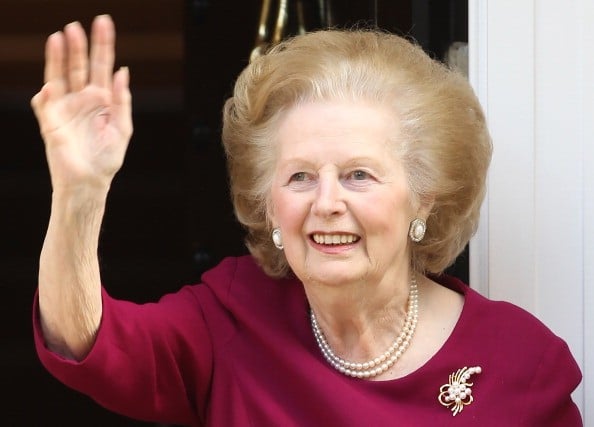Margaret Thatcher at a Glance
- Categories: Politicians, Politicians > Royals
- Net Worth: $10 Million
- Birthdate: Oct 13, 1925 - Apr 8, 2013 (87 years old)
- Birthplace: Grantham
- Gender: Female
- Profession: Lawyer, Chemist, Scientist, Politician, Statesman, Barrister
- Nationality: United Kingdom
- Height: 5 ft 5 in (1.66 m)
Margaret Thatcher: A Life in Politics and Legacy
Introduction: The Iron Lady’s Impact
Margaret Thatcher, a name synonymous with political and economic reform, remains a highly debated figure. As the first female Prime Minister of the United Kingdom, her leadership from 1979 to 1990 reshaped British society and its global standing. This comprehensive article delves into the life, career, policies, and lasting impact of Margaret Thatcher.
Early Life and Education
Born Margaret Roberts on October 13, 1925, in Grantham, Lincolnshire, England, Thatcher’s early life was marked by a strong work ethic and conservative values. Her father, Alfred Roberts, a grocer and local Methodist preacher, instilled in her a sense of duty and self-reliance. She attended Huntingtower Road Primary School and later Kesteven and Grantham Girls’ School on a scholarship, where she excelled in her studies and participated in various extracurricular activities, including piano, poetry, and field hockey. During World War II, she volunteered as a fire watcher with the Air Raid Precautions organization.
Her pursuit of higher education led her to Somerville College, Oxford, where she studied chemistry. She graduated in 1947 and earned a Master’s degree in 1950. During her time at Oxford, she was the president of the Oxford University Conservative Association, a testament to her early political inclinations.
Career Beginnings: From Chemistry to Politics
After graduating from Oxford, Thatcher initially pursued a career in chemistry. She worked as a research chemist for BX Plastics in Colchester, Essex, and later for J. Lyons & Co. in Dartford. However, her ambitions soon shifted towards politics. In 1950, she contested the Labour-held seat of Dartford as a Conservative candidate, repeating her candidacy in 1951, but lost on both occasions to Norman Dodds. She qualified as a barrister in 1953, further broadening her professional skills.
Early Government Positions: Rising Through the Ranks
In 1959, Thatcher entered Parliament as the Member of Parliament for Finchley. Her political career progressed steadily. She was appointed Parliamentary Undersecretary at the Ministry of Pensions and National Insurance. Later, she became the spokesperson for Housing and Land and subsequently moved to the Shadow Treasury in 1966. Her rise continued with her appointment to the Shadow Cabinet in 1967. After the Conservative Party won the general election in 1970, Thatcher was appointed Secretary of State for Education and Science. Her tenure in this role was marked by controversy when she ended free milk for schoolchildren, a decision that generated considerable public criticism.
Leader of the Opposition: Shaping a New Conservative Identity
In 1975, Thatcher was elected as the leader of the Conservative Party, becoming the first woman to hold this position. During her time as Leader of the Opposition, she played a key role in shaping a new direction for the Conservative Party, moving it towards neoliberal economic policies. Her focus was on reducing the size and scope of government, lowering taxes, and promoting free markets. Her strong stance against the Soviet Union earned her the nickname “Iron Lady,” which became a symbol of her resolute leadership.
Prime Minister: Thatcher’s Transformative Policies
Thatcher’s election as Prime Minister in 1979 marked a pivotal moment in British history. She implemented a series of policies aimed at revitalizing the British economy and curbing the power of trade unions. Key initiatives included:
- Economic Deregulation: Financial markets were deregulated, and state-owned industries were privatized.
- Tax Reform: Income taxes were lowered, while indirect taxes, such as VAT, were increased.
- Spending Cuts: Public spending on social services was reduced.
- Trade Union Reform: Legislation was introduced to curb the power of trade unions, leading to major strikes.
Her policies, while controversial, had a profound effect. While the UK initially faced a deepening recession and high unemployment, the Falklands War victory in 1982 and subsequent economic recovery helped solidify her popularity. She secured landslide reelection victories in 1983 and 1987. However, divisions within the Conservative Party over her policies, particularly on the European Union and the controversial poll tax, led to a challenge to her leadership and her resignation in 1990.

Dan Kitwood /Getty Images
Post-PM Career: Retirement and Later Years
After leaving office, Thatcher remained active in public life, serving in the House of Commons until 1992. She established the Margaret Thatcher Foundation, wrote two memoirs, and became a consultant for Philip Morris. These activities allowed her to remain a prominent voice in public discourse and shaped her legacy.
Personal Life and Death: Family, Health, and Legacy
In 1949, Margaret Roberts married Denis Thatcher, a businessman. They remained married until Denis’s death in 2003, and had twins, Mark and Carol. In her later years, Thatcher experienced health issues, including several small strokes and a diagnosis of dementia. She passed away on April 8, 2013, at the age of 87, following a stroke.
What was Margaret Thatcher’s Net Worth?
At the time of her death on April 8, 2013, Margaret Thatcher’s net worth was estimated to be $10 million. This reflected her earnings from her political career, her memoirs, and her consulting work after leaving office.
Conclusion: An Enduring Figure
Margaret Thatcher’s legacy is complex and multifaceted. While her policies and leadership style remain a subject of debate, her impact on British society and global politics is undeniable. She transformed the economic landscape of the UK, and her influence continues to resonate today. Whether viewed as a visionary leader or a divisive figure, Margaret Thatcher’s mark on history is assured.
/**/

